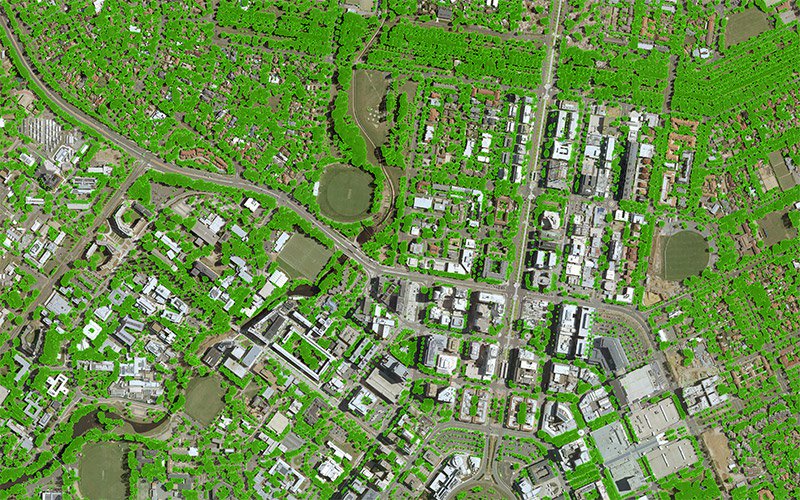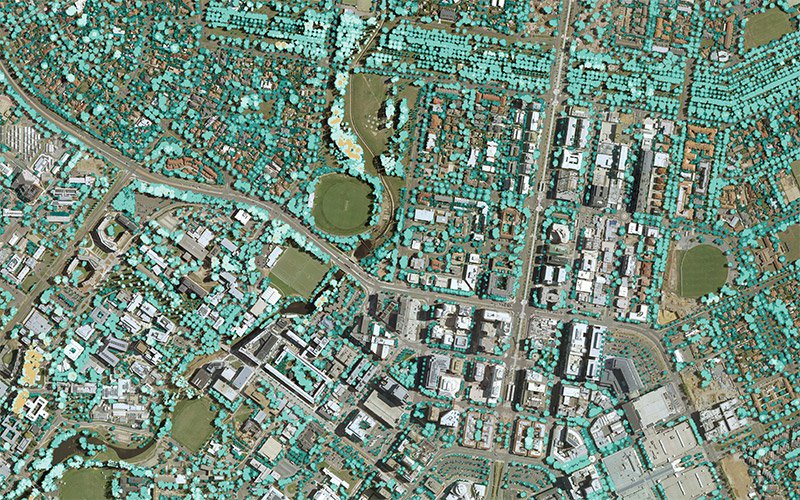Building sustainable urban areas is a core challenge for all levels of government. Having the correct data is critical for making long-term plans and tracking their effectiveness once implemented. That's where spatial data becomes so valuable.
We have developed a suite of LIDAR-derived Urban Vegetation, Tree Canopy, and Surface Mapping reports helping councils manage their spaces for better livability and health outcomes. These datasets can help councils and the Local and State Governments, city managers, and urban planners improve decision-making, refine policies, target investment, and make actionable strategies to mitigate climate change's ongoing effects.
A single LiDAR scan can be very powerful in generating an entire suite of reports. It's a scalable and consistent way to measure urban spaces, urban forest, and tree canopy data over time.
LiDAR scanners measure the return time, and intensity of laser pulses emitted from sensors mounted to fixed-wing aircraft flown over desired areas. Aerometrex has developed automated and manual classification systems for the LiDAR point clouds that get turned into the reports discussed below.
Repeat LiDAR measurements over time make change trackable over time with high precision.
Aerometrex has developed a way to measure and track changes in urban forests accurately.
'Urban forests' is a general term used to describe trees within the urban environment. Trees are significant assets that can mitigate adverse environmental effects and give many economic and social benefits. They positively affect community health, well-being, safety, improve local air quality, stormwater attenuation, combat climate change effects through carbon sequestration, and reduce urban heat islands.
LiDAR measures trees explicitly in three dimensions to accurately calculate a wide range of fundamental vegetation parameters. It combines easily with other quantitative datasets, such as aerial imagery, to combine large-scale accurate measurement to real-world context.

Left to right: Canopy Height Model, Canopy Coverage Map, Canopy Stratification Map, Canopy Coverage by Unit Area
Tree canopy reports help identify where new street trees, vegetation and water sensitive urban design initiatives could provide the most significant benefit for communities and identifying where building footprints have changed.
How can these reports help Local Government Areas (LGAs):
Canopy Coverage Maps show the precise boundaries of the tree canopies within your area of interest. They measure the total area covered by tree canopy within any region from individual streets and suburbs, council, or the entire metropolitan area. The Tree Canopy Coverage data combines with cadastral, land use, or land ownership datasets to give statistical breakdowns of tree canopy coverage across the community.

Canopy Coverage Map
Canopy Height Models give the precise height above the ground of the top of tree canopies. You can use CHMs to locate tall, significant trees, track tree growth, and identify trees that could potentially interfere with infrastructure. CHMs can significantly reduce the time and effort required to identify and plan tree asset maintenance.
Foliage Coverage Maps give the first-order estimate of vegetation density. The data adds context to the Canopy Height model to show the vegetation below the canopy. Overall vegetation density is an essential metric for tracking changes in the urban forest.
Canopy Coverage by Unit Area combines the tree canopy coverage with a unit area vector to show each cell's proportion covered by the tree canopy. This data provides the planners with a detailed understanding of tree canopy across their area of interest.
Canopy Stratification Maps measure the vertical structure and distribution of the urban forest. It's valuable data for tree management because it identifies different tree sizes and how they contribute to canopy coverage through their life cycles. Councils use it to track their planted trees' growth over time to gauge the effect of their greening activities. It also helps with tree preservation and maintenance activities over time.

Canopy Stratification Map
Canopy Change Detection shows where tree growth has increased canopy cover, and tree trimming and removals have decreased canopy cover. The reports summarise the extent of tree canopy gain or loss and separate that data into land ownership: private, government, and community-owned land. This data is essential in tracking tree canopy management strategies and combating the harmful effects of ongoing climate change.
Surface type and distribution in the urban environment is a strong indicator of an area's livability, sustainability, and resilience to the ongoing impact of climate change. Surface types directly affect heat buildup, water flow and runoff, and options for reaching greening targets.
The permeable and impermeable surface maps accurately show where water can and can't penetrate the ground.

A section of Canberra divided into permeable surfaces (green) and impermeable surfaces (red)
Permeable and impermeable surface classification can either act as a stand-alone deliverable or in a suite of data.
How can these surface maps help LGAs:

LiDAR is an efficient, scalable, and consistent way to measure large areas. This image shows Canberra's permeable and impermeable surfaces
The abundance of impermeable surfaces in the urban environment is the fundamental cause of surface water runoff challenges in densely populated areas. Impermeable surfaces also encroach on the sites available for urban green spaces.
Permeable and impermeable surface classification combines with the tree canopy mapping and urban forest solutions to help show where the trees are and plantable space in the urban environment.
Another benefit of these data sets is the ability to better understand the potential hazards of surface water runoff in dense urban areas during heavy rainfall events and get a detailed picture of surface water movement and accumulation on impermeable surfaces. High impermeable surface coverage also blocks water from replenishing the soil and water table.
Utilising these datasets can help government councils build environmental resilience and long-term community benefits.